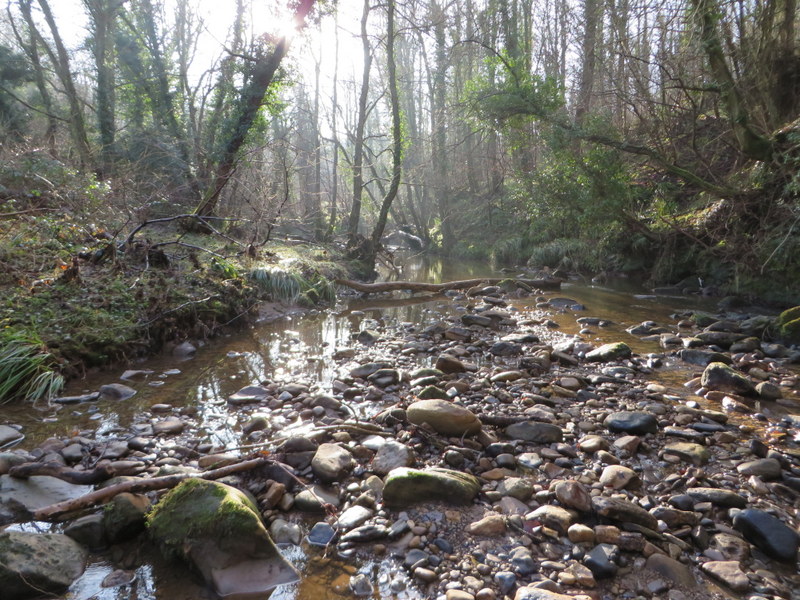Winter walks: Clarkson’s Wood on the morning and early afternoon of Sunday 29th January.
Posted on 31st January 2017
I drove across the moor road towards Liverton Mines, where we start, and the sunlight across the landscape was glorious with remnants of the overnight frost sparkling here and there.
And so was the walk really: Everything looked like this…

And felt like…

Anyway, to start, a brief intro to the history of the area and then a brisk warm-up walk straight out to stand in the middle of the viaduct where we looked right up the valley of ancient woodland; the sun raked the tree tops and warmed us as we chatted. The ruins of Kilton Castle, built around 1200, were lost amongst the trees on a promontory ahead of us but I showed photos of what was left of the dressed stone building and we talked about the land at the time of the Domesday Book.

Then what we were standing on; the mine spoil that covers the original viaduct has begun to get covered with vegetation 100 years after being dumped there. We compared the winter twigs of oak and ash, then wandered back to look at a huge specimen of goat willow and how its twigs differed from oak and ash. Repetition of looking and checking, and repeated naming of names, is the easiest way to remember I find.




And then we ambled off deep into the woods, stopping only to note the change of vegetation between ancient woodland and shale heaps, cobbled tracks, and then by a tree with deeply fissured bark; I mentioned how I’d previously thought this was grey poplar but you know when things rattle around in my head because you are just not quite sure, well that. So I’d picked up a leaf and checked with Stace 3*. Not grey, but a hybrid poplar – a cross between our native black poplar and a North American poplar which has been propagated by cuttings and planted here by someone probably for its timber, interestingly has the common name of Railway Poplar.

Then to a wet hollow with muddy paths where I was talking about deer eating ivy when suddenly a single magical Scarlet Elf Cup was spotted. As is often the case, there were more to find and I had inexplicably not seen them when I checked the walk earlier in the walk (well, not plants, what do you expect?).


Down the steps and by the footbridge we looked at the rock (probably middle-Jurassic deltaic sandstone (Saltwick Formation)) and we could see the strata of its formation.
Kate ‘oh I just found some otter spraint’ Bartram found some otter spraint on a flat rock under Petch Bridge, showed us it all and then washed her hands before replacing the gloves she’d borrowed to keep her hands warm. I’m sure she washed her hands. Anyway, it’s only fish they eat, right? That doesn’t smell, so I’m sure it’s fine. And they weren’t my gloves.

A brief pause for the Dutch Rush (the biggest patch of this scarcely found horsetail in our area) and then up the muddy track where the remains of a cambered cobble road could be seen. Chocolate stop at the top was milk, dark orange, dark with cocoa-nibs, and a very fine dark espresso.

On: Past the orange pond where the ironstone mine is leaking and up to a treasure trove of fungi on oak tree stumps, fallen oak branches, and then all the fallen birch trees which have reached the end of their natural life (about 80 years or so). Some particularly impressive old downy birch coppice here too.

At the choice between crossing the railway sleeper bridge and going up the steep steps, we went up the steep steps back up into the sunlight and through many coppiced sessile oak trees set amongst a carpet of greater woodrush to the top of the ancient wood.

Then a precarious drop down to scurry across the mine spoil until back to the wide path between the wood and the spoil heaps planted with young trees. A quick stop to look at the kissing tree (“that looks like someone’s bum”) before back along the muddy path to the street where the cars were parked.


The wood was magnificent; a joy to walk through – we are very lucky to have it owned by Redcar & Cleveland Council on behalf of local people and so easily accessible.

*Stace 3 is the third edition of the New Flora of the British isles by Clive Stace and the reference book I use for the naming of native plants. Very useful things are reference books to have on your bookshelves, although only if you actually use them.